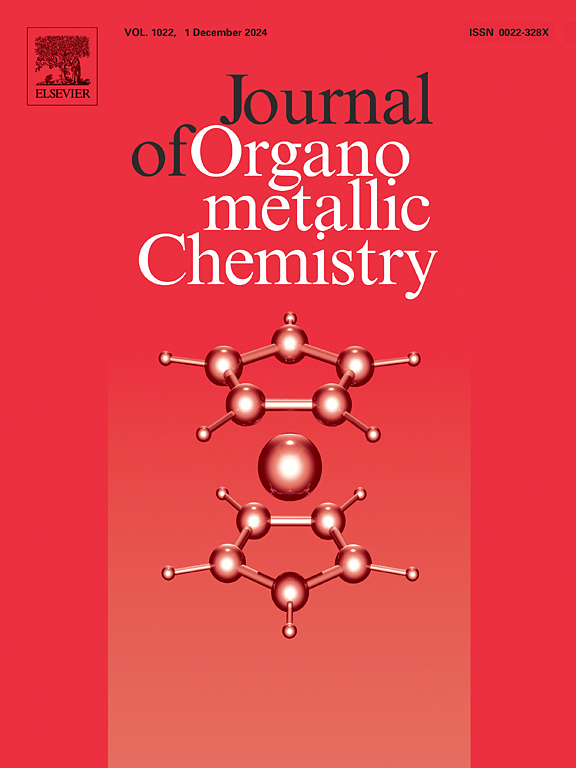Synthesis, crystal structure, Hirshfeld surface analysis, DFT studies and DNA binding interactions of N-ferrocenylmethyl-N-(3-cyanophenyl)acetamide
IF 2.1
3区 化学
Q3 CHEMISTRY, INORGANIC & NUCLEAR
引用次数: 0
Abstract
This work reports the synthesis, structural characterization, and biomolecular interaction of a new ferrocene-based molecule, N-ferrocenylmethyl-N-(3-cyanophenyl)acetamide (FcCN). The compound was secured through multi-step synthesis and structurally determined by SC-XRD to confirm a very robust sandwich-type ferrocene core with negligible distortion from the acetamide side chain. Electron Localization Function (ELF) and Localized Orbital Locator (LOL) analyses confirmed localized bonding in the organic backbone and delocalized electron density in the ferrocenyl group. Hirshfeld surface analysis showed that the crystal packing is stabilized mostly by H⋯H (53.0 %) and C⋯H/H⋯C (22.1 %) interactions, with significant contributions from N∙∙∙H and O∙∙∙H hydrogen bonds. Electrochemical measurements indicated a drastic negative shift in redox potential and reduction in peak current upon DNA binding, typical of the formation of a slowly diffusing FcCN-DNA adduct. DFT calculations corroborated the experimental data, with a HOMO–LUMO gap of 3.523 eV indicative of favourable stability and reactivity. Molecular docking predicted high DNA binding affinity (-6.9 kcal/mol) through groove interaction, and molecular dynamics simulation attested to the stability of the complex. These data highlight the prospects of FcCN as a redox-active, DNA-targeting entity and add to the increasing interest in ferrocene derivatives as therapeutic agents.

n -二茂铁甲基- n -(3-氰苯基)乙酰胺的合成、晶体结构、Hirshfeld表面分析、DFT研究和DNA结合相互作用
本文报道了一种新的二茂铁基分子n -二茂铁甲基- n -(3-氰苯基)乙酰胺(FcCN)的合成、结构表征和生物分子相互作用。通过多步合成和SC-XRD对该化合物进行了结构鉴定,证实了该化合物是一个非常坚固的三明治型二茂铁核,乙酰胺侧链的畸变可以忽略不计。电子定位函数(ELF)和定域轨道定位器(LOL)分析证实了有机骨架的定域键和二茂铁基的离域电子密度。Hirshfeld表面分析表明,晶体堆积主要由H⋯H(53.0%)和C⋯H/H⋯C(22.1%)相互作用稳定,其中N∙∙∙H和O∙∙H氢键的贡献很大。电化学测量表明,DNA结合时氧化还原电位急剧负移,峰值电流降低,这是缓慢扩散的FcCN-DNA加合物形成的典型特征。DFT计算证实了实验数据,HOMO-LUMO间隙为3.523 eV,表明具有良好的稳定性和反应性。分子对接通过凹槽相互作用预测了高的DNA结合亲和力(-6.9 kcal/mol),分子动力学模拟证明了该配合物的稳定性。这些数据突出了FcCN作为一种氧化还原活性、dna靶向实体的前景,并增加了人们对二茂铁衍生物作为治疗剂的兴趣。
本文章由计算机程序翻译,如有差异,请以英文原文为准。
求助全文
约1分钟内获得全文
求助全文
来源期刊

Journal of Organometallic Chemistry
化学-无机化学与核化学
CiteScore
4.40
自引率
8.70%
发文量
221
审稿时长
36 days
期刊介绍:
The Journal of Organometallic Chemistry targets original papers dealing with theoretical aspects, structural chemistry, synthesis, physical and chemical properties (including reaction mechanisms), and practical applications of organometallic compounds.
Organometallic compounds are defined as compounds that contain metal - carbon bonds. The term metal includes all alkali and alkaline earth metals, all transition metals and the lanthanides and actinides in the Periodic Table. Metalloids including the elements in Group 13 and the heavier members of the Groups 14 - 16 are also included. The term chemistry includes syntheses, characterizations and reaction chemistry of all such compounds. Research reports based on use of organometallic complexes in bioorganometallic chemistry, medicine, material sciences, homogeneous catalysis and energy conversion are also welcome.
The scope of the journal has been enlarged to encompass important research on organometallic complexes in bioorganometallic chemistry and material sciences, and of heavier main group elements in organometallic chemistry. The journal also publishes review articles, short communications and notes.
 求助内容:
求助内容: 应助结果提醒方式:
应助结果提醒方式:


